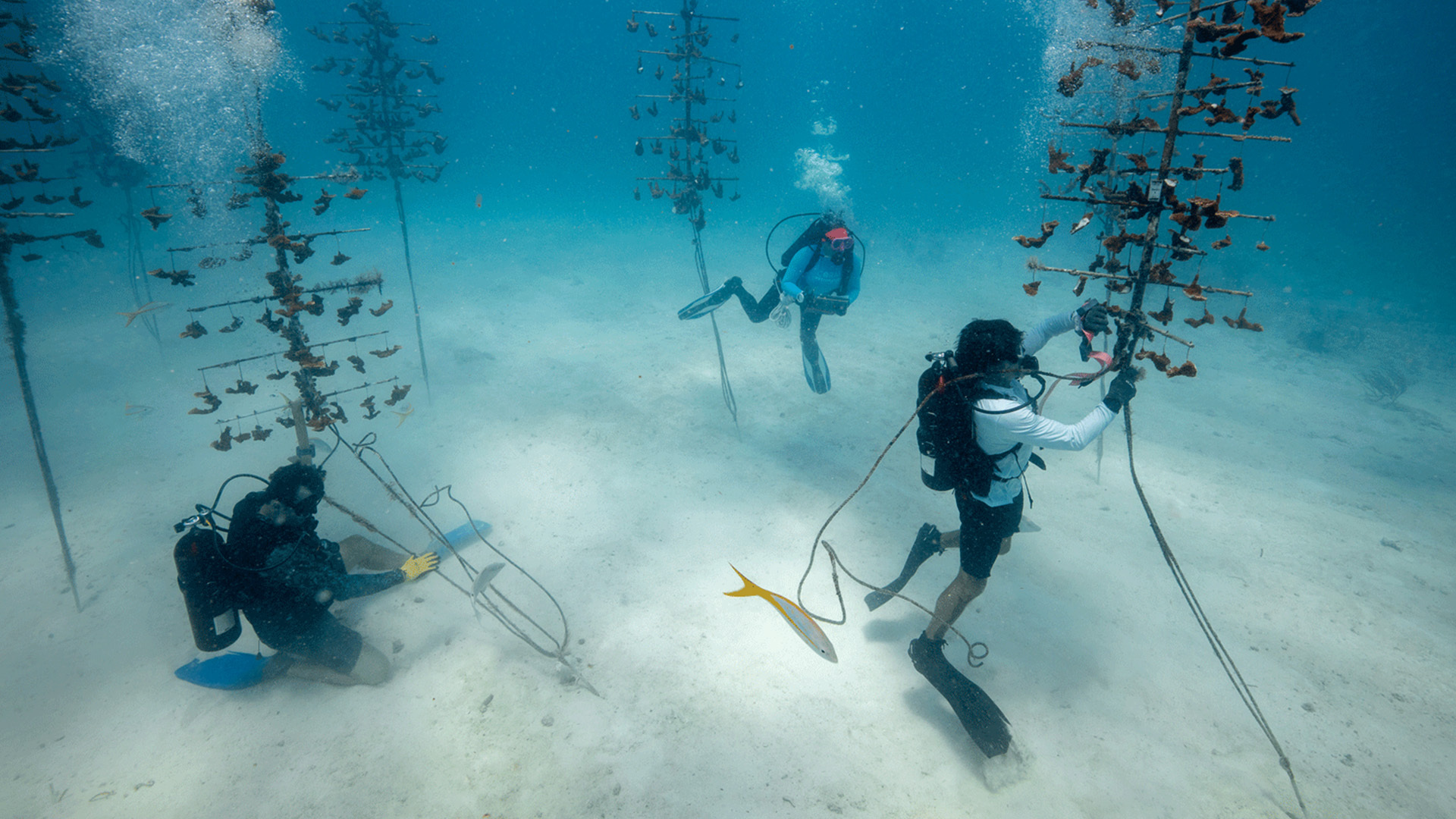
[EMMA STOLTZFUS]
EXTREME WEATHER ROCKED THE US THIS YEAR. SUMMER BROUGHT A MASSIVE HEAT WAVE THROUGHOUT THE WORLD, TRIGGERING STORMS, BREAKING RECORDS AND GENERALLY MAKING LIFE MISERABLE. UNDER THE WAVES, THE OCEAN WAS ALSO HEATING UP, CAUSING A WIDESPREAD CORAL BLEACHING EVENT.
[DR. CINDY LEWIS, DIRECTOR | KEYS MARINE LABORATORY]
CORAL RESTORATION IS AN IMPORTANT PART OF SALVAGING THE ECOSYSTEM DOWN HERE, TRYING TO SAVE THESE CORALS. AND THIS HEATWAVE THIS SUMMER CAME SO FAST, SO HARD, AND SO EARLY THAT IT WAS VERY DIFFICULT TO PREPARE FOR IT.
[EMMA STOLTZFUS]
THAT’S DR. CINDY LEWIS, THE DIRECTOR OF THE KEYS MARINE LABORATORY.
WHEN TEMPERATURE SPIKES STRIKE, CORAL NORMALLY CAN’T JUST MIGRATE TO COOLER WATERS. AT LEAST, NOT WITHOUT A LOT OF HELP. DR. LEWIS’ LAB AND SEVERAL OTHER ORGANIZATIONS JUMPED IN TO SAVE THE FRAGILE CORAL NURSERIES OFF THE FLORIDA KEYS. THEY HOSTED AROUND 5,000 SPECIMENS IN SPECIAL CONTAINERS ON LAND DURING THE OCEAN HEAT WAVE.
[DR. CINDY LEWIS]
IT WAS HOT AND WE HAD DAYS, 90 TO 94 DEGREE AIR TEMPERATURE DAYS, WITH HEAT INDEXES OVER 115 DEGREES — AND WE’RE TRYING TO MAINTAIN CORAL AT 85 DEGREES TO 86 DEGREES, WHICH WAS WAY BETTER THAN WHAT THEY WERE SEEING ON THE REEF. WE WERE GETTING REPORTS BETWEEN 88 AND 92 DEGREES ACTUALLY ON THE REEF WHERE THESE CORALS CAME FROM.
THE BIGGER CHALLENGE WAS FEEDING THESE CORALS AND CLEANING THE TANKS AND ASSESSING THESE CORALS EVERY SINGLE DAY. 5,000 CORALS WITH AN ARMY OF PROBABLY 50 TO 100 PEOPLE OVER THE COURSE OF THE SUMMER, ROTATING THROUGH AND SPENDING HOURS AND HOURS OUT THERE IN 90 TO 94 DEGREE WEATHER.
[EMMA STOLTZFUS]
THE WATERS AROUND FLORIDA, AND MUCH OF THE WORLD, STAYED AT BLEACHING ALERT LEVEL TWO FOR SEVERAL MONTHS. THIS CAUSED A SPREADING UPHEAVAL IN THE FRAGILE CORAL ECOSYSTEM, CAUSING THEM TO EXPEL THEIR SYMBIOTIC ALGAE AND TURN WHITE FROM STARVATION. LEVEL TWO IS THE HIGHEST POINT ON NOAA’S ALERT SCALE, WARNING THAT SEVERE MORTALITY AND BLEACHING ARE LIKELY.
[DR. CINDY LEWIS]
THEY LOOK LIKE BIG GIANT SNOWFLAKES. BUT IN REALITY, IT’S NOT A GOOD THING. — WE JUST STARTED GETTING WATER TEMPERATURES DOWN TO NORMAL LEVELS WITHIN THE LAST MAYBE THREE TO FOUR WEEKS. SO THEY HAD TO SURVIVE FROM JULY, AUGUST, SEPTEMBER AND THROUGH HALF OF OCTOBER. AND THAT’S A LONG TIME FOR THEM TO MAINTAIN, TO LIVE AT THAT UPPER LEVEL OF TEMPERATURE TOLERANCE.
[EMMA STOLTZFUS]
IN SOME PLACES THE SURFACE OCEAN TEMPERATURE REACHED CRITICAL LEVELS, RAISING WARNING FLAGS AROUND THE WORLD, INCLUDING THE WHITE HOUSE.
[ALLISON CRIMMINS, DIRECTOR | FIFTH NATIONAL CLIMATE ASSESSMENT]
WATERS OFF THE COAST OF FLORIDA HIT 101 DEGREES FAHRENHEIT, EXPOSING OUR NATION’S PRECIOUS CORAL REEFS TO HOT-TUB-LEVEL TEMPERATURES. CLIMATE IMPACTS ARE COSTING LIVES, DISRUPTING LIVELIHOODS, AND THREATENING THE PEOPLE, PLACES, AND PASTIMES WE CARE ABOUT.
[EMMA STOLTZFUS]
NOW THE OCEAN HAS COOLED DOWN ENOUGH FOR THOSE CORALS TO BEGIN THE RETURN JOURNEY TO THE OCEAN. THE CONCLUSION OF A SIGNIFICANT OPERATION THAT STILL REQUIRES A VARIETY OF QUALIFICATIONS TO BE MET.
CINDY LEWIS, DIRECTOR | KEYS MARINE LABORATORY
FIRST, THE REEFS HAD TO BE COOL. SECOND, THEY HAD TO BE INSPECTED VISUALLY TO DETERMINE THAT THEY WERE HEALTHY. AND THEN WITH THAT HEALTH CERTIFICATE IN HAND, THEN WE’RE ALLOWED TO BRING THEM BACK TO THEIR NURSERIES WHERE THEY ORIGINATED FROM.
THERE IS JUST AN UNDERTONE OF AMAZING EXCITEMENT WITH EVERYBODY THAT’S ON SITE, MOVING THESE CORALS, GETTING THEM BACK INTO COOLERS, AND BACK TO THE BOATS, AND DIVING TO GET THEM BACK DOWN TO THE NURSERIES. AND EVERYBODY IS JUST SO EXCITED THAT EVERY CORAL RETURNED IS A SUCCESS. YES, WE’VE LOST SOME — BUT THE ONES THAT SURVIVED, IT’S A HUGE SUCCESS.











